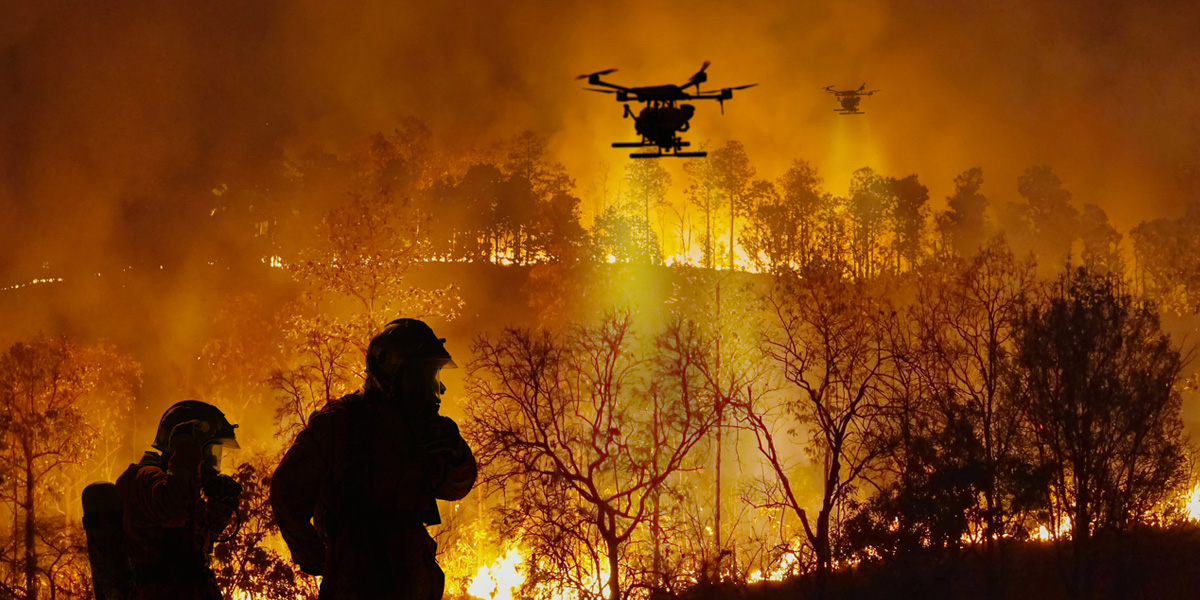The prevalence of wildfires as a growing part of our lives is, unfortunately, likely to continue. Global leaders in recent years have warned that wildfires and climate change are mutually exacerbating, meaning that at the same time:
- Climate change leads to more dangerous fire seasons due to shifts in humidity levels, wind speeds and more.
- Wildfires contribute negatively to climate change by damaging sensitive ecosystems, making it harder to halt rising temperatures.
The destructive power of wildfires have made them a major topic of interest. For example, according to the National Interagency Coordination Center’s Wildland Fire Summary and Statistics Annual Report from 2024, there were 64,897 wildfires in the U.S. in 2024 compared to 56,580 in 2023, a 14.7% increase. Additionally, wildfires consumed 8,924,884 acres in the U.S. in 2024 compared to 2,693,910 in 2023, a 231.3% increase. Both the number of fires and acres burned were above the national five and 10-year averages.
Thankfully, government organizations, private sector companies and fire service leaders are all developing new methods and standards for wildfire prevention, mitigation and recovery. If you’re a current firefighting professional or looking to enter the field, here are some key wildfire trends to monitor in 2025 and beyond.
1. Technological Advancements in Wildfire Prevention
As wildfires become more frequent and intense, innovative technologies are playing a crucial role in enhancing prevention and management strategies. These tools are transforming how fire service professionals detect, predict and respond to wildfires, offering new ways to protect ecosystems and communities.
For example, autonomous helicopters and drones, developed by startups like Rain, are enhancing response capacities by operating in low visibility conditions, such as night and high winds.
Additional technological advancements in fire prevention include:
- Mobile Doppler radar systems that facilitate early detection and provide comprehensive insights into fire dynamics.
- Satellite surveillance that utilizes thermal imaging to detect wildfires in remote or nighttime conditions.
- Synthetic Aperture Radar (SAR) that provides continuous monitoring and high-resolution terrain data, overcoming optical limitations to assess fire risks effectively.
2. Understanding the “Wildfire Urban Interface”
The devastating fires in Los Angeles in January 2025 highlighted the critical challenges posed by the "wildfire urban interface," the zone where urban development meets natural areas. In an article published by the Los Angeles Times, experts Jack Cohen and Stephen Pyne were quoted explaining that this interface is often misunderstood, with assumptions that large flames are the primary cause of destruction. Instead, they emphasized the role of wind-driven embers in igniting structures well beyond the initial areas of danger, transforming what are traditionally seen as wildland fires into urban disasters.
This calls for a shift in focus toward fortifying homes and communities – through measures such as fire-resistant building materials and community-driven landscaping efforts – to prevent fires from spreading out of control in populated areas. By redefining the problem, communities can better prepare for and mitigate the impacts of future fire events.
3. Wildfires in Low-Risk Regions
While the wildfires in the western United States and Canada have been some of the largest and most high-profile, other regions in North America have also fallen victim to climate effects which can lead to wildfires. Areas like the northeast, which historically have been low-risk, are starting to face greater incidences of drought, which leads to vegetation drying out and higher chances of wildfires.
As a result, more and more locations which have been historically unaffected by major wildfire risk may experience them more often, on a larger scale, and during “offseason” times. This may result in firefighting professionals in low-risk regions altering and expanding their training to include wildfire prevention and mitigation.
4. Government and Private Sector Investment in Wildfire Mitigation
The shocks created by wildfires to sectors like the housing market, insurance and health care have spurred proposals for investing in wildland fire management from government agencies and utility companies. For example, California regulators have approved a program aimed at expediting the “undergrounding” of power lines to mitigate wildfire risks. According to Pacific Gas and Electric Company, undergrounding eliminates nearly 98% of the risk of wildfire ignition from electrical equipment. However, the high costs – ranging from $1.85 million to $6.1 million per mile – have raised concerns about affordability for consumers, especially given recent rate increases.
5. Energy Demands and Fire Risks
A major risk factor for the improvement of the power grid is the rapidly increasing domestic demand for energy, fueled mostly by the growing number of energy-intensive data centers. These projects, which form the physical infrastructure necessary for new technologies like AI and data storage, are already consuming the equivalent of a state’s worth of energy.
Even as utility companies work to limit fire risk, they will be tasked with finding sustainable and safe ways to provide huge amounts of energy. While it is possible to make the energy grid safer, this expansion inevitably creates more risk, as each wire, cluster of batteries, or other piece of machinery is a potential fire vulnerability.
Fire Science Education at Columbia Southern University
Firefighting offers a highly challenging and rewarding career. Here at Columbia Southern University, our degree programs in fire science are designed by the nation’s most distinguished fire service professionals and are recognized through Fire and Emergency Services Higher Education (FESHE), a network of the U.S. Fire Administration’s National Fire Academy.
If you’d like to learn more about CSU degree programs in fire science, visit our programs page.
Multiple factors, including prior experience, geography and degree field, affect career outcomes. CSU does not guarantee a job, promotion, salary increase, eligibility for a position, or other career growth.





